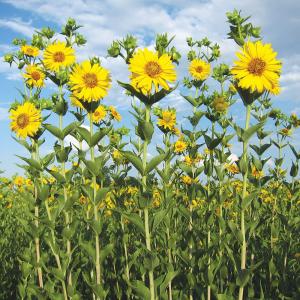2023 - Volume #47, Issue #6, Page #36
[ Sample Stories From This Issue | List of All Stories In This Issue | Print this story
| Read this issue]
Perennial Oilseed Showing Potential
 |
Work at The Land Institute developing silphium has spread to multiple universities in the intermountain states and the Midwest.
“We’re still very much in the research and development stage, working on selecting the most preferable strains and then bulking out the seed,” says Tammy Kimbler, The Land Institute. “The seed will be used in regional testing in the U.S. and also in Argentina, where there’s much less pest pressure because it isn’t a native.”
Silphium provides a good habitat for earthworms, hoverflies (pollinators and aphid eaters), native bees, Monarch butterflies, and honeybees. It doesn’t spread and is a strong candidate to provide soil protection and carbon sequestration.
David Van Tassel, The Land Institute lead researcher, has doubled seed size and selected for other desirable attributes. In an interview on The Land Institute website, he described discovering that winter kill is not a problem, even in places like Minnesota and Vermont. Neither are high temperatures and humidity, given a successful plot in Texas.
Insect and fungal pests appear to be the biggest challenges. Van Tassel has identified rust-resistant strains and plans to cross them with higher-yielding strains. Some lines also seem to be resistant to a predacious moth. He’s identified strains with larger flower heads and shown that cutting stems down can cause the plant to branch out and produce heads at the same heights.
Seed from selected lines is shared with cooperating researchers, where they are looking at multiple end uses depending on the growing environment. Silphium is recognized for its drought tolerance due to root depths of 4 to 6 ft. In areas where that is a concern, it’s being evaluated as a forage crop. Where moisture is not a factor, it’s being evaluated for oilseed production and other benefits.
Don Wyse with the Forever Green Initiative, University of Minnesota, notes that the deep roots are suited to intercept leached fertilizer before it enters groundwater.
“Cattle love it and will eat it to the ground, and intermountain universities are looking at it for forage,” says Kimbler. “It’s also a prime forage for honeybees and is being evaluated for honey production at the University of Minnesota and Central Ohio State University. Minnesota researchers are also looking at it for grain production and as a continual living cover crop.”
As with Kernza (Vol. 40, No. 1), the perennial grain developed under the leadership of The Land Institute, genetic mapping has been vital for research on silphium.
“We now have a gene package we can share with our collaborators to identify traits of harvestability, stand and yield,” says Kimbler. “Completing the genome map of silphium and a couple of close relatives was a fundamental piece of the program and will allow us to accelerate the research.”
The Land Institute is also working on other potential perennial field crops, including perennial sorghum.
“In the next 5 to 7 years, we hope to introduce even more perennial crops,” says Kimbler.
Contact: FARM SHOW Followup, The Land Institute, 2440 E. Water Well Rd., Salina, Kan. 67401 (ph 785-823-5376; www.landinstitute.org).

Click here to download page story appeared in.

Click here to read entire issue
To read the rest of this story, download this issue below or click here to register with your account number.




